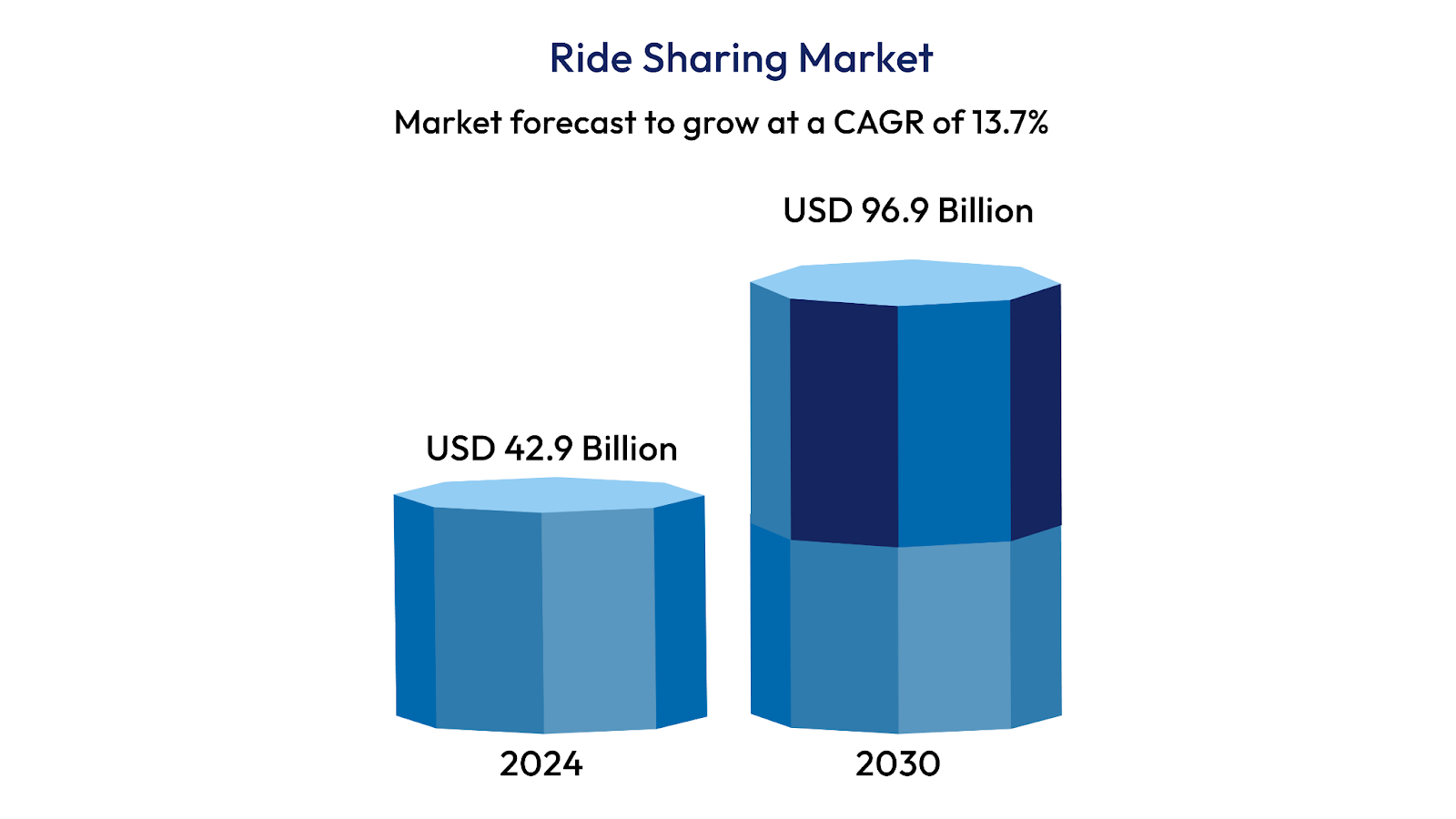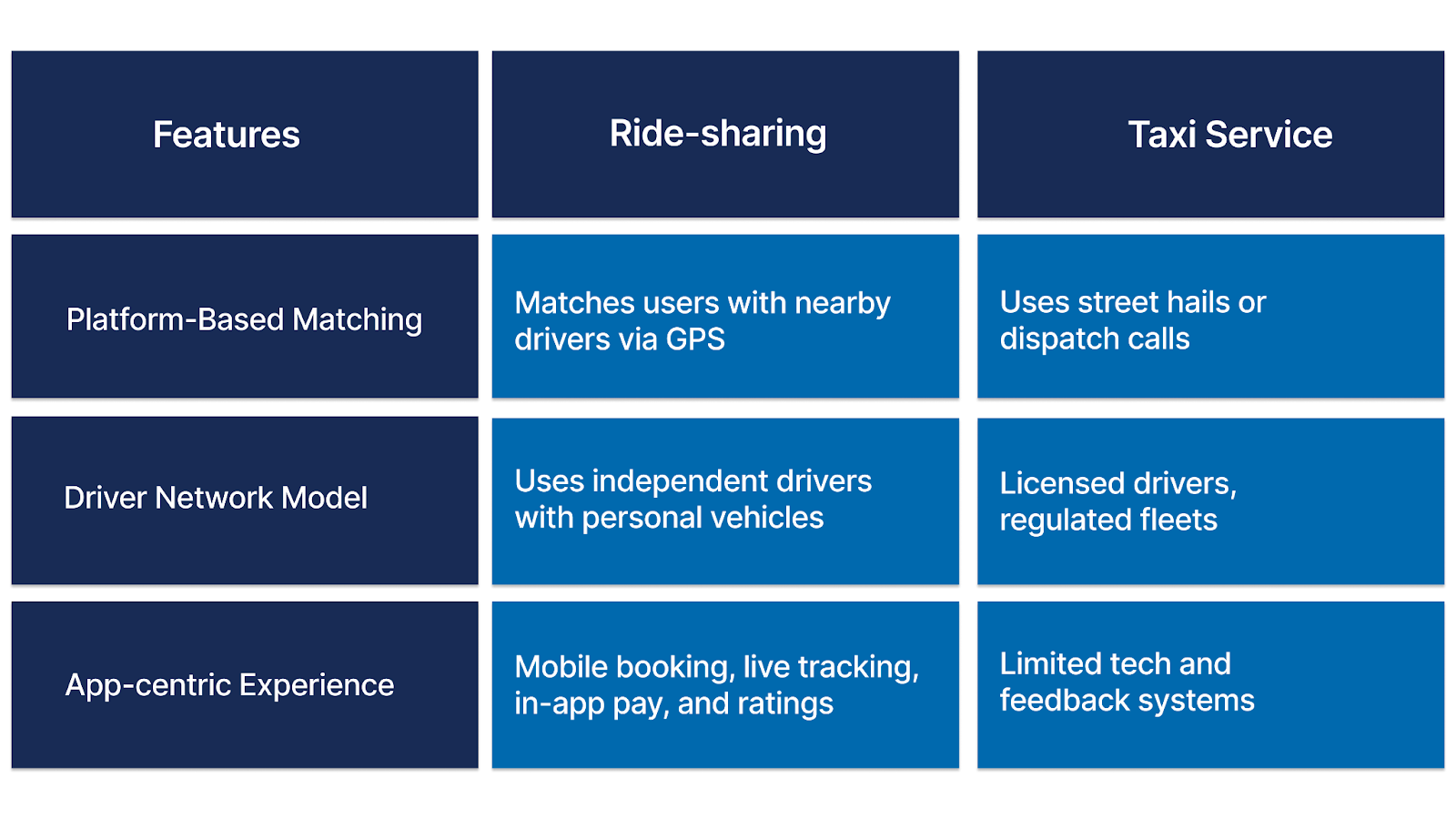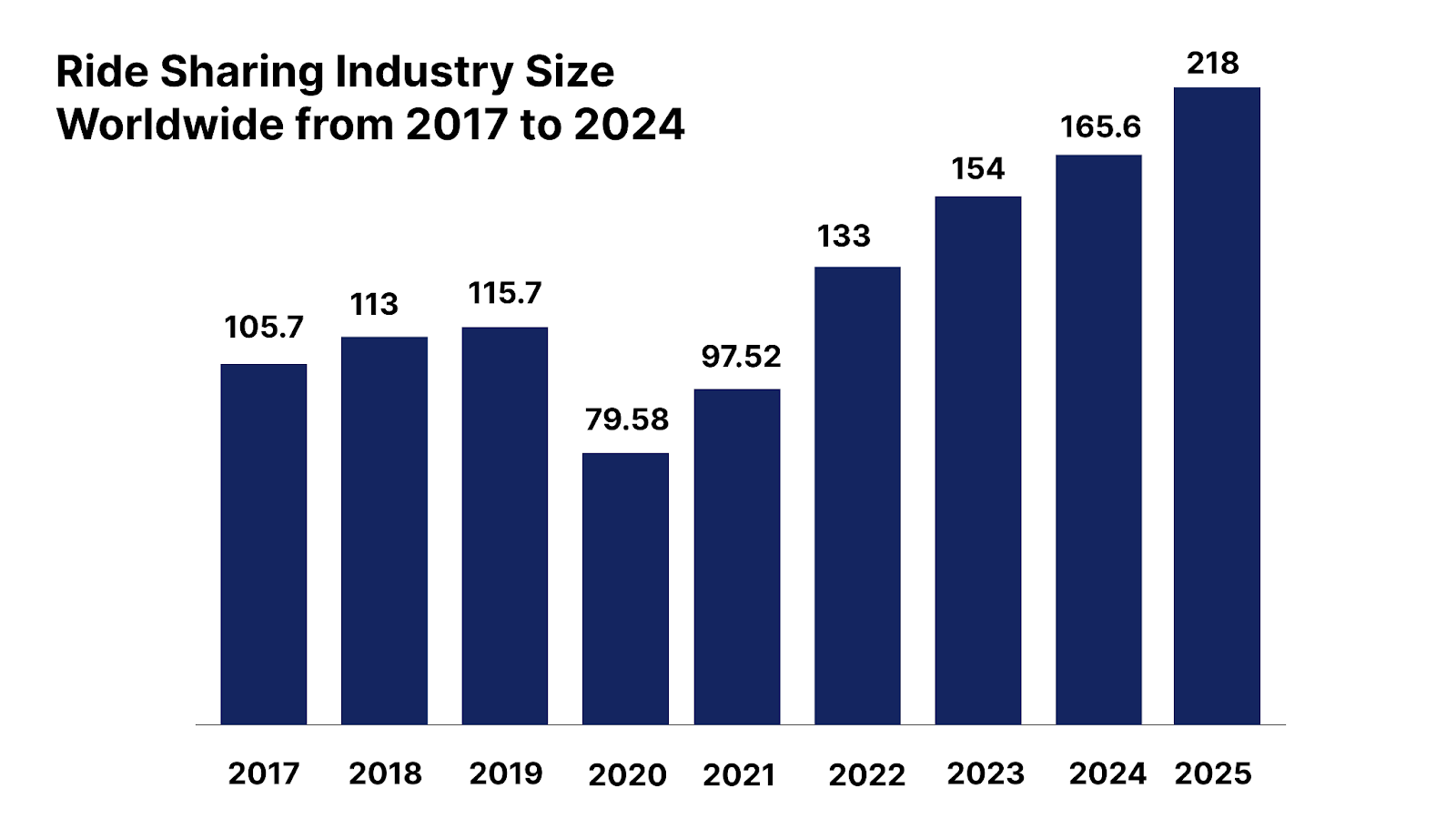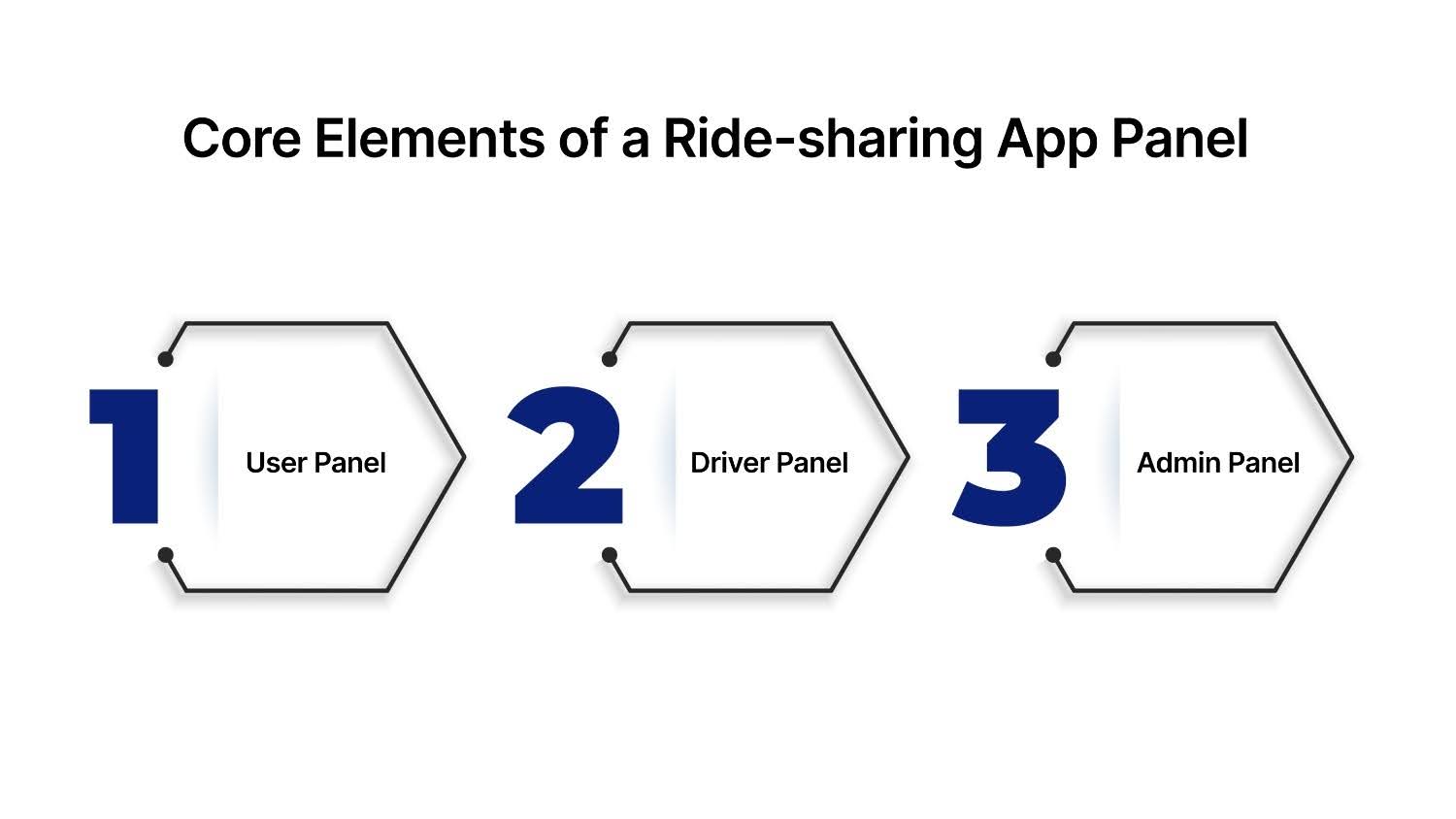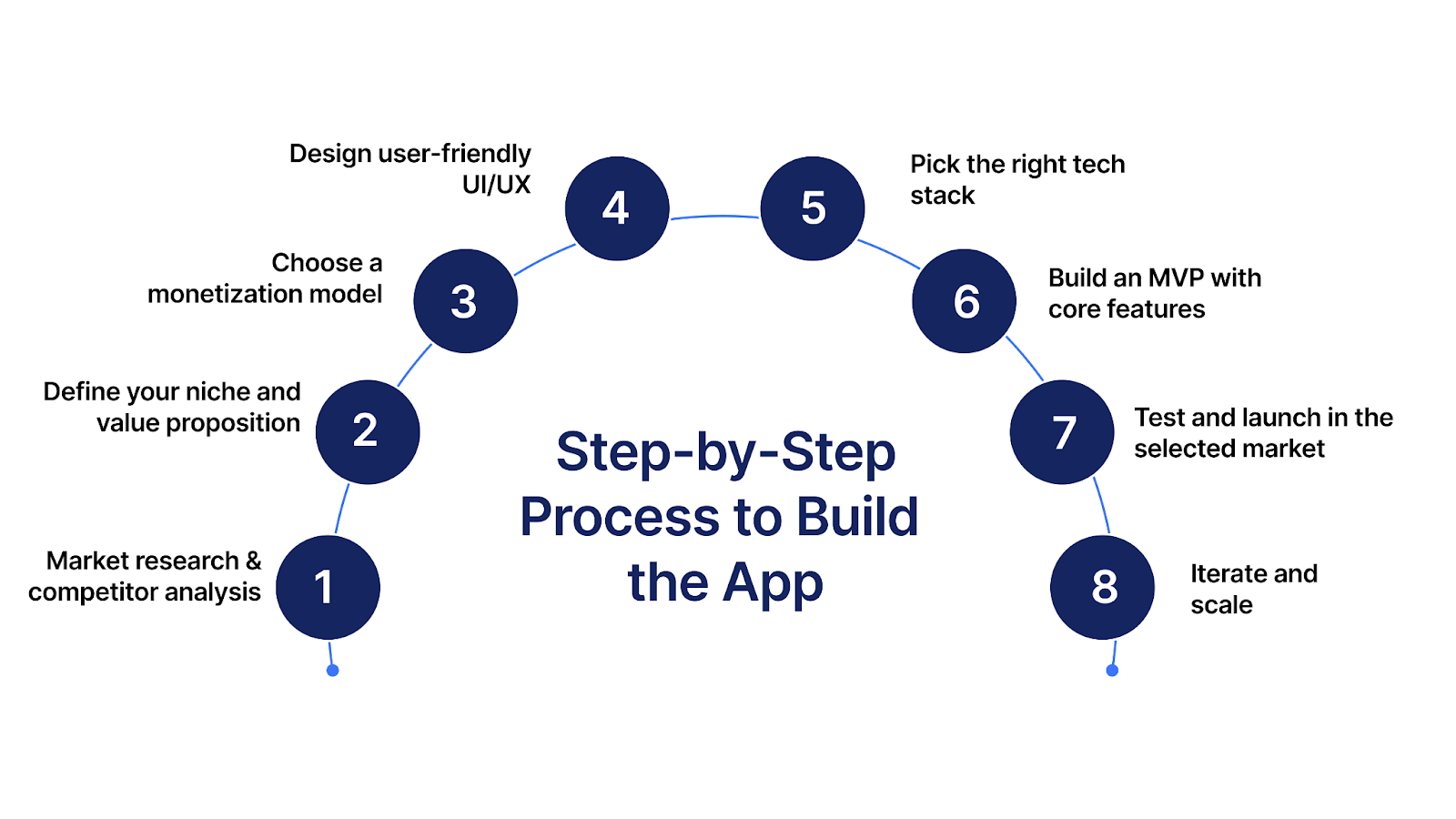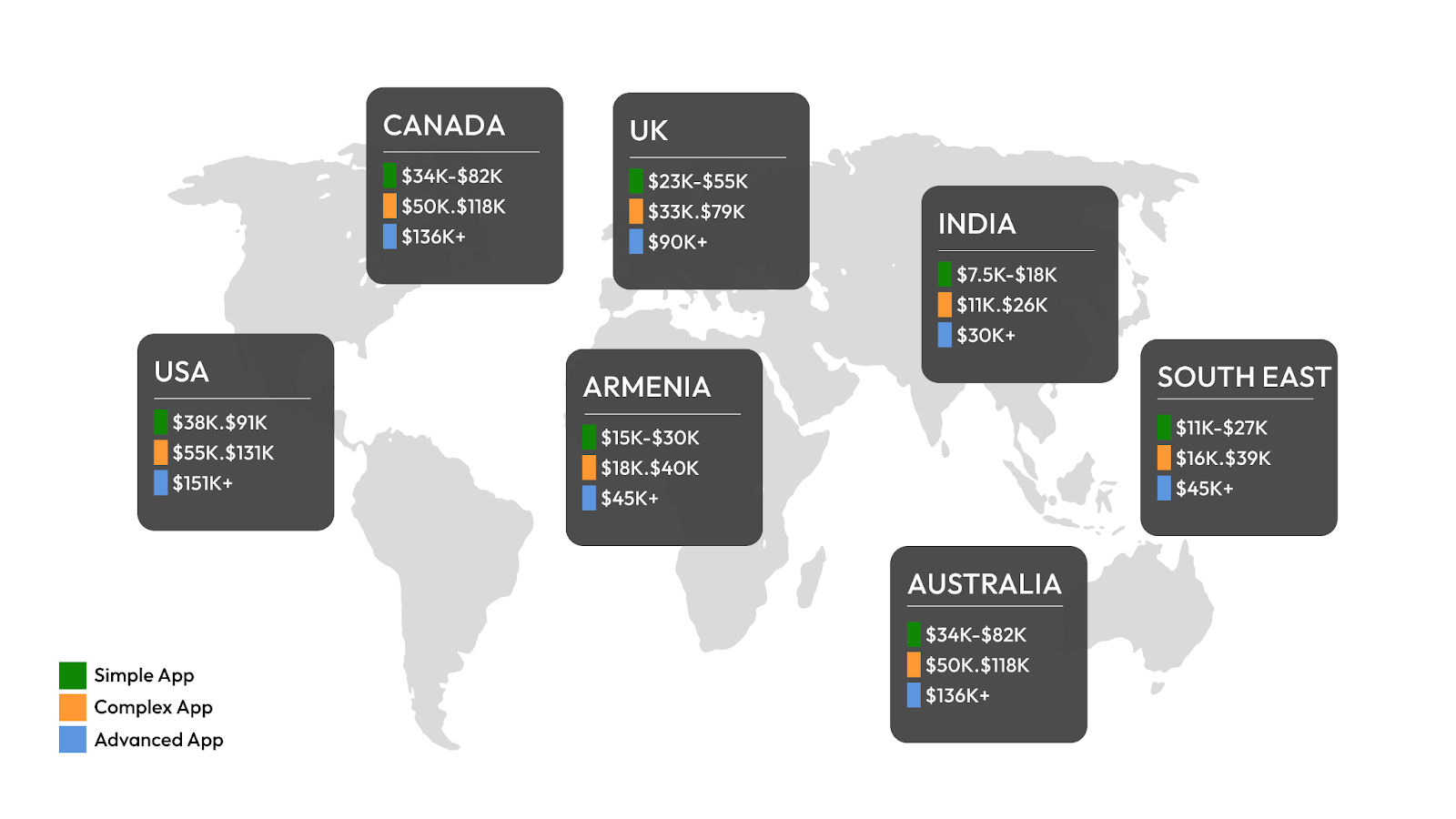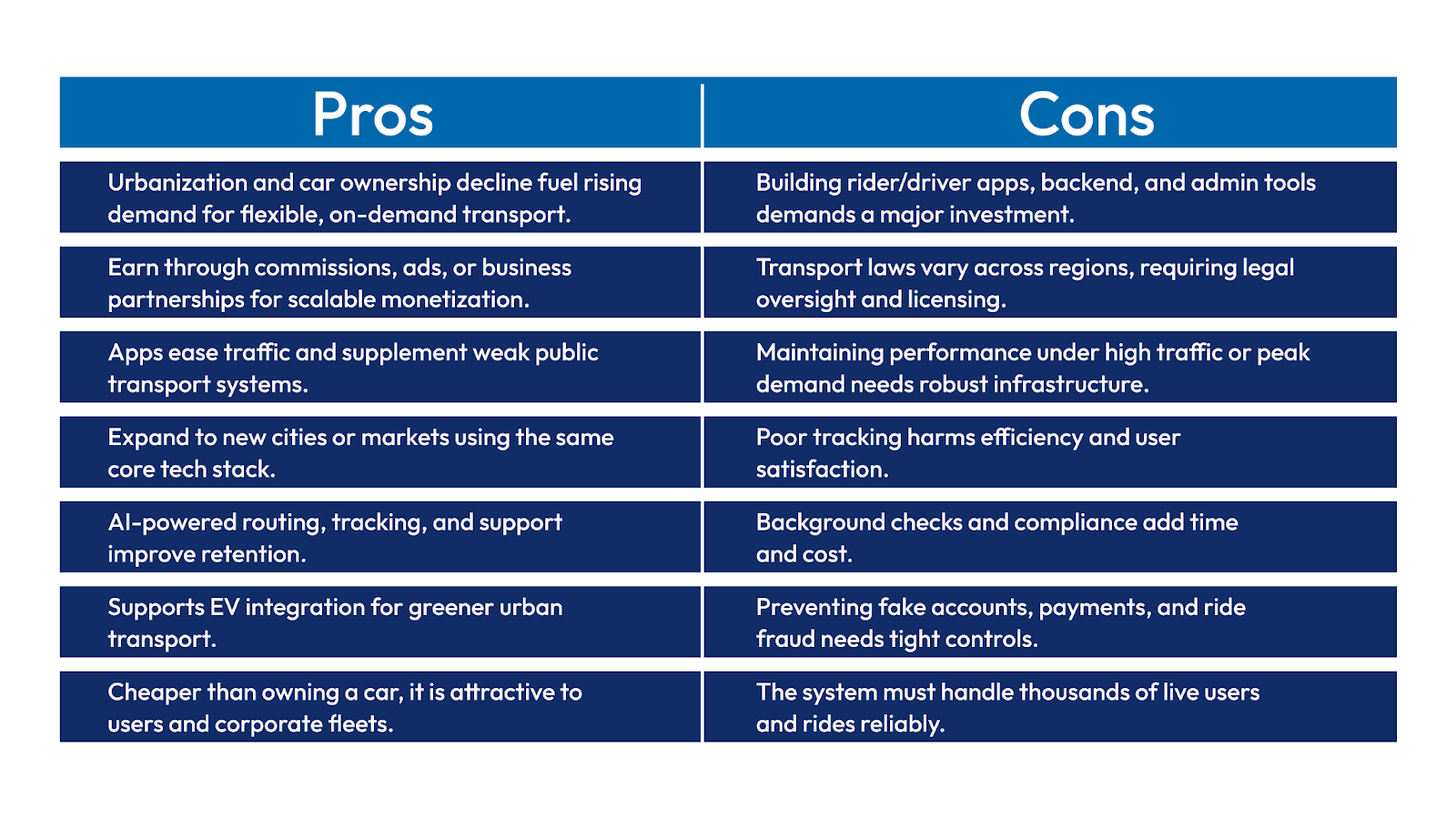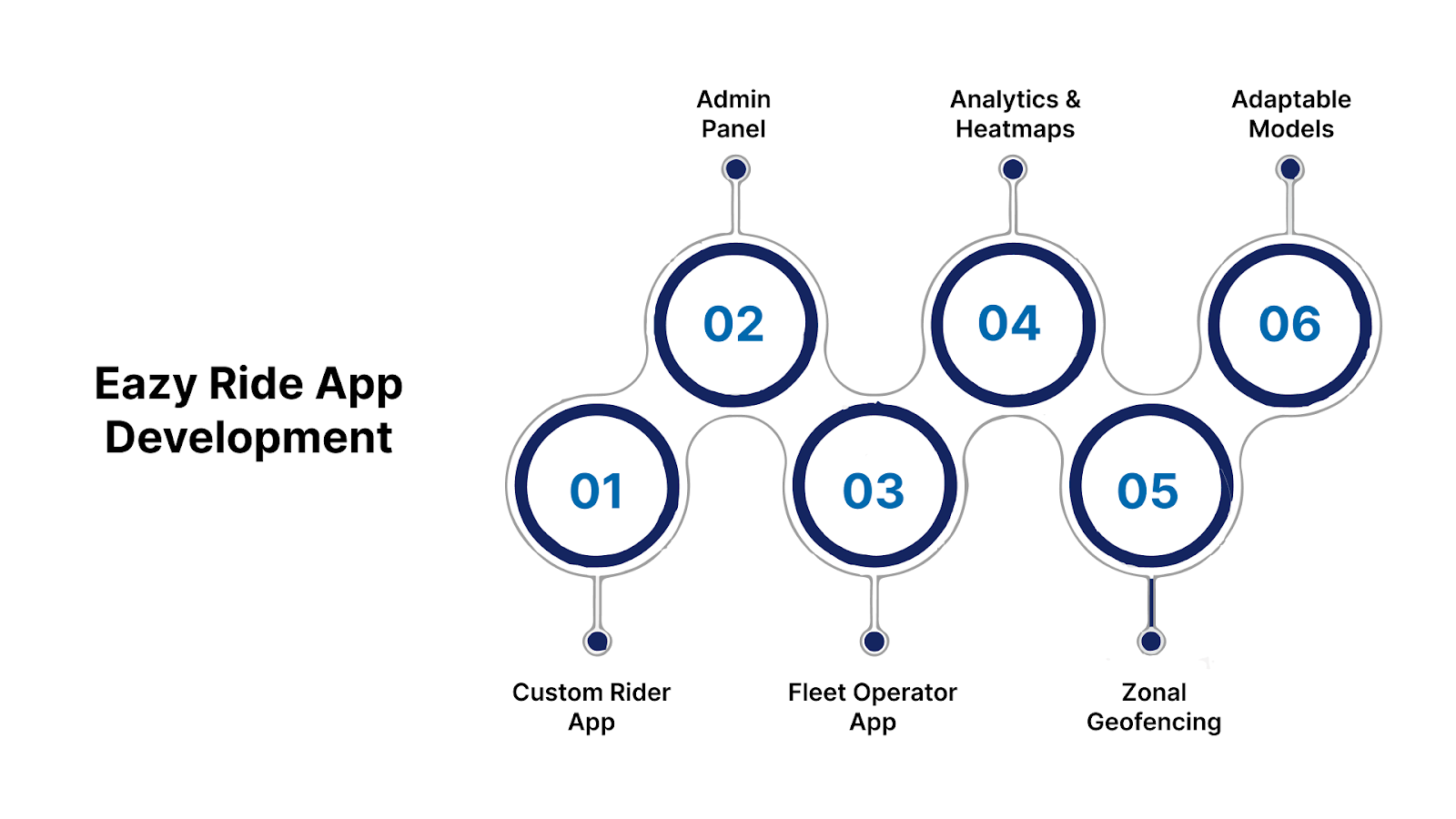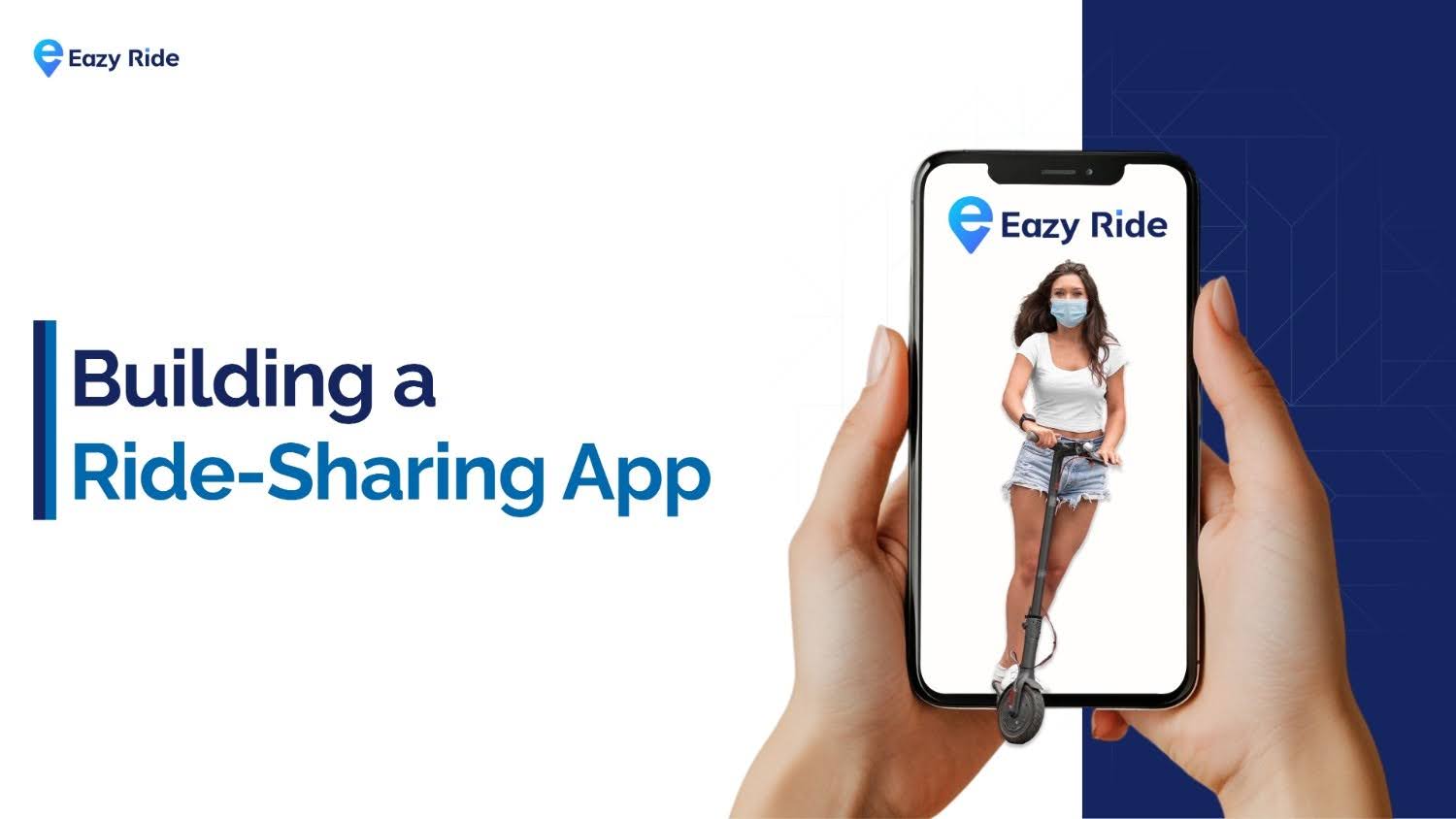 Analytics and research
Analytics and research
Building a Ride-Sharing App: Steps and Cost Guide
How can you turn your existing fleet into a revenue-driving ride-sharing business before your competitors do?
With urban congestion on the rise and public transport systems under pressure, cities are leaning on flexible mobility solutions. That’s where you come in.
Yet launching a ride-sharing service isn’t just about having vehicles on the road; it’s about building the right tech, logistics, and growth strategy from day one.
Ride-sharing is no longer a fringe innovation; it’s a booming industry projected to hit $96.9 billion globally by 2030, growing at a steady 13.7% CAGR. For fleet managers, the numbers are hard to ignore.
In this blog, we will walk you through the important steps of ride-sharing app development, including the key components, must-have features, and the challenges businesses face when building a successful platform. You’ll also learn about the costs involved, so it can help you deploy a fully functional app within weeks.
What is a Ride-Sharing App?
A ride-sharing app is a digital platform that connects passengers with nearby drivers through a smartphone interface. It replaces traditional taxi booking with live location matching, route optimization, and cashless transactions.
For users, it means instant access to rides, transparent pricing, and in-app support. For drivers, it offers flexible income opportunities with built-in navigation and earnings tracking tools.
From an operational side, these apps include admin dashboards, analytics, and zoning tools to manage fleets, monitor demand, and scale services across cities.
How Does Ride-Sharing Differ from Traditional Taxi Services?
Ride-sharing apps have redefined urban transport by using mobile technology to deliver faster, more flexible service. Unlike traditional taxis, these platforms prioritize user experience, smart logistics, and scalable operations. For startups or city planners, understanding these differences is crucial before entering the mobility market. Let’s look at those differences:
This shift in service models has fueled rapid global adoption, making it essential to examine where the ride-sharing industry stands today.
Market Overview of the Ride-Sharing Industry
The ride-sharing market is rapidly evolving, and by the end of this year, it is expected to reach $218 billion. Giants like Ube, Curb, and Lyft dominate the North American market.
Top 3 Ride-sharing Apps:
-
Curb: Curb is the new name for the Taxi Magic app and allows users to book a cab and pay with their phone.
- Uber: A market leader offering global coverage and a vast range of ride-hailing services.
- Lyft: Another major player in North America, focusing on eco-friendly transportation options.
However, building a ride-sharing app requires extensive must-have features to add. Knowing these key points is crucial for a decision-maker in a business.
Core Elements of a Ride-sharing App Panel
When creating a ride-sharing app development plan, it’s important to design distinct panels for the three main stakeholders: users, drivers, and administrators. Each panel has unique needs and features that will ensure a smooth and efficient experience for all parties involved. Below is a breakdown of the key features and functionalities for each stakeholder’s panel.
User Panel
Easy Registration
The user panel should offer a registration process that allows users to sign up quickly through their email or phone number.
A smooth sign-up experience will ensure that new users can start using the app with minimal friction. Simplified registration helps increase conversion rates and makes it easier for customers to return to the app.
Booking Interface
The booking interface should be intuitive, allowing users to easily input their trip details, such as pickup and drop-off locations.
It should also provide options for ride types, vehicle preferences, and additional services such as ride-sharing or eco-friendly options. A clear, simple interface will lead to a better user experience and faster booking times.
GPS & Location Tracking
Integrating GPS technology allows users to track their ride’s live location. This feature provides transparency, ensuring users are informed about their driver’s arrival time and current location.
Live-location tracking also helps users feel more secure, as they can monitor their ride progress from start to finish.
Fare Estimator
A fare estimator helps users understand the cost of their ride before they book it. Calculating an estimated fare based on the distance and ride type ensures there are no surprises when the ride is completed. Providing a clear and reliable fare estimate builds trust between users and the platform, helping to reduce complaints.
Payment Integration
Users should be able to pay through multiple methods, including credit/debit cards, digital wallets, and in some cases, cash.
Payment integration needs to be secure, fast, and easy to use. Multiple payment options enhance the flexibility of your platform, catering to a wider audience with different preferences.
Ratings & Reviews
The ratings and reviews feature allows users to rate their ride experience and provide feedback. This helps ensure quality control by providing valuable insights into both drivers’ performance and the overall ride experience. Ratings build transparency and accountability, benefiting both drivers and passengers.
Ride History, Search Filters, Chat & Call, Reservation & Cancellation
Users should have easy access to their ride history, allowing them to view past trips, payment details, and ratings. Search filters let users find services that match their preferences, such as car type or driver ratings.
The ability to chat and call drivers or support improves communication and resolves issues quickly. Lastly, reservation and cancellation options give users flexibility, ensuring they can modify or cancel their ride without hassle.
Driver Panel
Profile Management
The driver panel should allow drivers to manage their personal details, vehicle information, and necessary documents.
This feature ensures that all drivers comply with regulatory requirements and that their profiles are up-to-date. A simple, organized profile management system helps drivers quickly make changes and stay in compliance.
Ride Alerts & Requests
This feature sends instant alerts to drivers about incoming ride requests. They can review the details, including passenger location and destination, before accepting the ride.
Timely requests help drivers stay efficient and reduce idle time, making sure they never miss an opportunity.
Navigation & Route Optimization
A built-in navigation system helps drivers find the best route to their destination, considering live traffic conditions.
Route optimization ensures that drivers take the most efficient path, reducing wait times and fuel consumption. This improves the overall experience for both drivers and passengers, helping to maximize earnings.
Contact Passenger & Review Ratings
The ability to contact passengers directly through chat or call enhances communication, helping resolve issues before or during the ride.
Additionally, reviewing ratings allows drivers to provide feedback on passengers, ensuring that both drivers and passengers maintain a high standard of service. This mutual feedback system improves the overall quality of the service.
Earnings Dashboard
An earnings dashboard provides drivers with insights into their daily, weekly, and monthly earnings, helping them track their performance.
This feature also provides transparency in commission deductions and bonuses. A clear earnings overview motivates drivers to optimize their time and maximize their income.
Availability Toggle
Drivers can use the availability toggle to indicate when they are ready to accept rides. This simple feature allows drivers to manage their schedule efficiently, ensuring they only receive ride requests when they are available. It helps improve driver satisfaction by allowing them to work on their terms.
Admin Panel
User & Driver Management
The admin panel allows administrators to manage both users and drivers efficiently. This includes onboarding new drivers, verifying their profiles, and addressing user complaints.
Admins can also ensure that both drivers and users comply with the platform’s terms of service, ensuring smooth operations.
Analytics Dashboard
The analytics dashboard provides live insights into ride data, including ride frequency, revenue generation, and fleet performance.
This feature helps businesses make informed decisions, identify trends, and adjust strategies accordingly. Data-driven insights help improve operational efficiency and profitability.
Real-Time Monitoring
Admin teams can use real-time monitoring to track the status of ongoing rides and fleet operations. This feature is essential for ensuring that the service is running smoothly and that issues can be resolved promptly. Monitoring helps detect problems before they affect customer satisfaction.
Revenue Tracking & Commission Management
The revenue tracking feature allows administrators to monitor the platform’s overall earnings, including ride fares, service fees, and commissions.
This tool also helps manage commission structures, ensuring that drivers and the platform’s business model remain profitable. Transparent revenue tracking helps maintain financial control and operational transparency.
These core elements will help you to understand what could be necessary to make your app people-friendly. However, you do not want to miss out on knowing about the absolute must-have features for your app.
Must-Have Features of a Ride-Sharing App
When building a ride-sharing app, it’s crucial to offer both core and advanced features that meet user expectations while driving business success. A well-designed app should prioritize user convenience, safety, and smooth operation for both passengers and drivers.
Below are the must-have features every ride-sharing app needs to succeed in the market:
Core Functionalities
Notifications (Push, SMS, Email)
Keep users informed at every stage with live-location notifications. Push, SMS, or email notifications alert users about ride status, driver arrivals, or special offers, making them feel connected with the service.
Booking & Matching Algorithm
The booking system should smoothly match passengers with nearby drivers. This feature uses a smart algorithm to reduce wait times and improve ride efficiency.
Emergency/SOS Button
An emergency button within the app ensures the safety of both drivers and passengers. The SOS feature sends immediate alerts to emergency contacts or services in case of any issues during the ride.
Advanced Features
Surge Pricing
Implement surge pricing during high-demand periods, such as rush hours or bad weather, to ensure ride availability and maximize revenue.
Multi-Language Support
Offer multi-language support to cater to a diverse range of users, especially in international cities. This feature enhances user accessibility and broadens the market reach.
Loyalty Programs
Reward loyal customers with discounts, free rides, or other incentives to encourage repeat business and improve customer retention.
With a clear understanding of the must-have features, the next step is to break down how to build your ride-sharing app, from planning to launch.
Step-by-Step Process to Build the App
Ride-sharing app development is like solving a real-world transport challenge with a structured approach. You need a strategy that connects product design, market insight, and long-term scalability. Below is a roadmap to take your idea from concept to launch:
Step 1: Market research and competitor analysis
- Start by studying your target users, cities, and usage patterns.
- Look at competitors like Uber and Lyft, and analyze regional models.
- Identify gaps, pricing, accessibility, or vehicle options that your app can address.
Step 2: Define your niche and value proposition
- Clarify what makes your service unique.
- Your niche determines feature priorities, pricing logic, and marketing channels. Without this step, your brand risks becoming generic and unmemorable.
Step 3: Choose a monetization model
- Decide how the app will earn revenue.
- Your monetization strategy should match your target market’s expectations and the service scale.
Step 4: Design user-friendly UI/UX
- Your interface should simplify tasks, booking, payments, and cancellations across all user panels.
- Focus on clarity, consistency, and speed. Test early with mockups to refine flows before development.
Step 5: Pick the right tech stack
Select scalable, secure, and performance-focused tools.
- Native apps for iOS and Android are standard, but frameworks like Flutter or React Native can also work for MVPs.
- Back-end decisions (Node.js, Python, Firebase, etc.) impact how your app performs under real-time loads.
Step 6: Build an MVP with core features
- Launch with the minimum viable product (MVP) that covers registration, booking, payments, and GPS.
Add advanced features in phases.
Step 7: Test and launch in the selected market
- Choose a controlled environment like a mid-sized city or campus.
- Conduct functional, load, and usability tests.
- Use soft launches to fine-tune features, monitor feedback, and fix bugs.
Step 8: Iterate and scale
- Post-launch, use analytics to track adoption, retention, and revenue metrics.
- Scale by expanding zones, adding more vehicles, or offering subscription packages.
- Keep improving with user feedback and new technologies like AI-based dispatch or heatmap analytics.
Once you have a clear development roadmap, the next critical consideration is cost. From infrastructure to integrations, let’s break down what it takes financially to build a competitive ride-sharing app.
Cost Breakdown of a Ride-sharing App Development Program
Developing a ride-sharing app involves many moving parts, from design and engineering to testing and launch. Your total investment depends on the scope of work, your development partner’s location, and how complex the features are.
A minimum viable product typically includes core functionalities such as registration, booking, payments, and GPS tracking. It’s ideal for early-stage testing in one city or zone. This phase helps you validate demand before scaling further.
Full-featured app: $100,000–$150,000
A full version includes advanced features like route optimization, geofencing, admin analytics, loyalty programs, and fleet monitoring. It also supports multiple user roles, larger fleets, and integrations with third-party services.
You can refer to the image below to understand the ongoing costs for worldwide regions.
Monetization Models
The financial viability of a ride-sharing business depends heavily on choosing the right revenue model. These models affect your market positioning, user growth, and long-term sustainability.
Commission Model
- This is the most common model, where the platform takes a percentage from each trip fare.
- This model aligns directly with trip volume and incentivizes more active drivers and riders.
Partnerships
- Strategic alliances with businesses such as restaurants, airports, hotels, and event venues can be your go-to model.
- This offers co-branded promotions, exclusive drop-off zones, and integrated booking.
- It increases brand visibility while sharing revenue or lead conversions with partners.
Advertising
- This model allows you to earn revenue by allowing contextual ads inside your rider and driver apps.
- It includes sponsored trip suggestions, discount codes, or partner banners.
- Driver-partnered promos (like in-car samples or flyers) are also viable in high-density cities using this model.
Building a ride-sharing app is great, but you may find yourself in trouble if you fail to assess the pros and cons.
Pros and Cons of Building a Ride-Sharing App
Launching a ride-sharing platform can be a high-reward venture, but it also requires careful consideration of the challenges and limitations that come with it.
Below, we break down both the Pros and Cons to help guide your decision-making:
Since the cons are critical to ignore, you need a platform that will fully support you in building your dream ride-sharing app. And, Eazy Ride can be your best deal in this situation. How? Let’s find that out.
How does Eazy Ride help in Ride-Sharing App Development?
When it comes to building a successful ride-sharing app, Eazy Ride offers a comprehensive solution that tackles various challenges businesses face in this competitive market.
Here’s how Eazy Ride helps address the key needs of a ride-sharing business:
- White-Label Rider App: Eazy Ride provides fully customizable mobile apps for both iOS and Android. With this app, businesses can offer riders the ability to seamlessly locate, unlock, and ride vehicles.
- Admin Dashboard: It centralizes all fleet operations into a single platform, allowing businesses to track key metrics and ensure optimal performance across the fleet.
- Fleet Operator App: The Fleet Operator App simplifies the management of vehicle maintenance, rebalancing, and servicing.
- Analytics & Heatmaps: With Eazy Ride’s AI-powered Analytics & Heatmaps, businesses can access valuable data on trip frequency, peak zones, and idle times.
- Geofencing & Zonal Control: This makes it easy to set up geofencing controls, enabling businesses to manage parking areas, no-go zones, and speed restrictions.
- Flexible Business Models: Eazy Ride supports multiple business models. This versatility allows companies to customize their operations to their specific market.
Wrapping Up
The ride-sharing industry continues to present strong opportunities for businesses willing to invest in smart, scalable solutions. However, development hurdles like system load and operational control can slow progress.
Eazy Ride helps bridge that gap with a ready-to-deploy platform for modern mobility needs. Launching in one city or scaling across regions? You’ll have the tools to move faster and manage without starting from scratch.
FAQs
1. How long does it typically take to launch a functional ride-sharing platform?
Timelines vary, but building from scratch often takes 6–12 months. With a white-label solution like Eazy Ride, businesses can launch in as little as 2 weeks, which is ideal for MVP testing or regional rollouts.
2. What are the common mistakes startups make when entering the ride-sharing space?
Many overbuild early features, delay monetization planning, or skip critical compliance steps. It’s crucial to launch lean, validate demand fast, and integrate flexible admin controls from day one.
3. Can a ride-sharing app be adapted for non-urban environments like campuses or resorts?
Yes. Ride-sharing platforms are increasingly being used in private ecosystems like universities, gated communities, and corporate parks.
4. How can I future-proof my ride-sharing app for multi-modal integration?
Choose an architecture that allows you to add new vehicle types (e-bikes, shuttles) without rebuilding. API-first platforms with modular service layers are key.
5. What’s the best way to test market viability before a full-scale launch?
Start with a geo-restricted soft launch using limited vehicles and promo-based acquisition. Use AI-based analytics to track usage, retention, and demand hotspots. Platforms like Eazy Ride offer heatmap tools to support this strategy.


